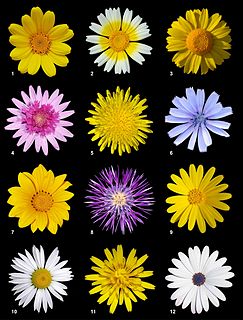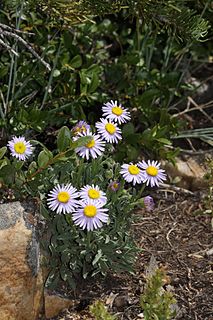
The family Asteraceae, alternatively Compositae, consists of over 32,000 known species of flowering plants in over 1,900 genera within the order Asterales. Commonly referred to as the aster, daisy, composite, or sunflower family, Compositae were first described in the year 1740. The number of species in Asteraceae is rivaled only by the Orchidaceae, and which is the larger family is unclear as the quantity of extant species in each family is unknown.

Chaenactis xantiana, the Mojave pincushion or Xantus pincushion, is a flowering plant in the family Asteraceae, native to the western United States, from southeastern Oregon, Nevada, southern and eastern California and northwestern Arizona. It is very common in the Antelope Valley in the Mojave Desert, and grows in sandy soils.

Chaenactis is a genus of plants in the daisy family which are known generally as pincushions or dustymaidens.

Symphyotrichum lateriflorum is a species of flowering plant in the aster family (Asteraceae). Commonly known as calico aster, starved aster, and white woodland aster, it is native to eastern and central North America. It is a perennial and herbaceous plant that may reach heights up to 120 centimeters and widths up to 30 cm (1 ft).

Chaenactis fremontii, with the common names Frémont's pincushion and desert pincushion, is a species of annual wildflower in the daisy family. Both the latter common name, and the specific epithet are chosen in honor of John C. Frémont.

Chaenactis artemisiifolia, with the common name white pincushion, is a species of flowering plant in the daisy family. It is native to the coastal Peninsular Ranges of Southern California and Baja California, in the chaparral and woodlands.
Chaenactis alpigena is a species of flowering plant in the daisy family known by the common name southern Sierra pincushion. It is native to the High Sierra Nevada and the White Mountains of California, extending in the latter just into Nevada.

Chaenactis carphoclinia is a species of flowering plant in the daisy family known by the common name pebble pincushion. It is native to the southwestern United States and northwestern Mexico, where it grows in rocky and gravelly habitat, such as the California deserts. The species is found in southern California, Nevada, Utah, Arizona, southwestern New Mexico, Baja California, Sonora.

Chaenactis douglasii is a North American species of flowering plant in the daisy family known by the common name Douglas' dustymaiden.

Chaenactis glabriuscula, with the common name yellow pincushion, is a species of flowering plant in the daisy family. It is native to California and Baja California.

Chaenactis macrantha is a species of flowering plant in the daisy family known by the common names bighead dustymaiden and Mojave pincushion. It is native to the Great Basin and the southwestern deserts of the United States, in California, Arizona, Utah, Nevada, southwestern Idaho, and southeastern Oregon. It grows in dry, open habitat with gravelly, sandy soils, often calcareous or alkaline in nature.

Chaenactis santolinoides is a species of flowering plant in the daisy family known by the common name Santolina pincushion. It is found in California.

Chaenactis stevioides, with the common names Esteve's pincushion and desert pincushion, is a species of flowering plant in the daisy family.

Chaenactis suffrutescens is a species of flowering plant in the aster family known by the common name Shasta chaenactis.

Erigeron tener is a North American species of flowering plant in the family Asteraceae known by the common name slender fleabane. It is native to the western United States, largely in the Great Basin, in the states of California, Arizona, Nevada, Utah, Oregon, Wyoming, Idaho, and Montana.

Allium nevii, known by the common name Nevius' onion or Nevius' garlic, is a plant species native to central Washington and north-central Oregon in the United States. It grows in wet meadows and along stream banks at elevations up to 2000 m.

Chaenactis thompsonii is a North American species of flowering plants in the aster family known by the common name Thompson's pincushion. It is found only in the northern Cascades in the US State of Washington.
Chaenactis evermannii is a North American species of flowering plants in the aster family known by the common name Evermann's pincushion. It is found only at high altitudes in the mountains in the central part of the US State of Idaho.
Chaenactis cusickii is a North American species of flowering plants in the aster family known by the common name Morning brides or Cusick's pincushion. It has been found only in southeastern Oregon and southwestern Idaho.
Reuben Denton Nevius was an American botanist and Episcopal priest, missionary, and the first registrar of the Diocese of Olympia, Washington.













